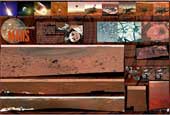
 |
|
|
|
This is the third edition of the classic textbook written by two of the world's leading radio astronomers. It provides a comprehensive review of the subject, both in terms of the instruments and techniques employed and the knowledge of the Universe that are revealed by them. The first half of the book describes how radio sources emit radio waves and how radio telescopes are used, both as single dishes and increasingly in arrays of antennas, to receive and analyse them. It covers the newly developing radio telescope arrays such as LOFAR - the low frequency array that spans Europe, ALMA - the Atacama Large Millimetre Array in Chile - and, now being designed, the Square Kilometre Array which will give astronomers a capability to probe the ‘dark ages’ before the formation of the galaxies. The second half of the book reviews the observations of our Universe made with them, from our own Galaxy and the stars and pulsars within it to distant radio galaxies and quasars powered by super-massive black holes. A significant addition to this edition is the provision of two new chapters on cosmology – the origin and evolution of the Universe – including the latest observations of the Cosmic Microwave Background made by the WMAP spacecraft. It must be stressed however, that this is a graduate text book and thus employs a high level of mathematics throughout – perfect for its intended reader, but somewhat daunting for the amateur astronomer who might wish to learn more about radio astronomy. Having said that, there is no doubt that a keen reader could ignore the mathematics and still get a very good feel of how our understanding of the Universe has been greatly enhanced by this exciting branch of astronomy. Ian Morison |
|
|
|
2009 Yearbook This 132-page special edition features the ultimate observing guide for 2009, a review of all the biggest news stories of 2008, in depth articles covering all aspects of astronomy and space missions for 2009, previews of International Year of Astronomy events and much, much more. This 132-page special edition features the ultimate observing guide for 2009, a review of all the biggest news stories of 2008, in depth articles covering all aspects of astronomy and space missions for 2009, previews of International Year of Astronomy events and much, much more.Infinity Rising  This special publication features the photography of British astro-imager Nik Szymanek and covers a range of photographic methods from basic to advanced. Beautiful pictures of the night sky can be obtained with a simple camera and tripod before tackling more difficult projects, such as guided astrophotography through the telescope and CCD imaging. This special publication features the photography of British astro-imager Nik Szymanek and covers a range of photographic methods from basic to advanced. Beautiful pictures of the night sky can be obtained with a simple camera and tripod before tackling more difficult projects, such as guided astrophotography through the telescope and CCD imaging.Exploring Mars  Astronomy Now is pleased to announce the publication of Exploring Mars. The very best images of Mars taken by orbiting spacecraft and NASA's Spirit and Opportunity rovers fill up the 98 glossy pages of this special edition! Astronomy Now is pleased to announce the publication of Exploring Mars. The very best images of Mars taken by orbiting spacecraft and NASA's Spirit and Opportunity rovers fill up the 98 glossy pages of this special edition!Mars rover poster  This new poster features some of the best pictures from NASA's amazing Mars Exploration Rovers Spirit and Opportunity. This new poster features some of the best pictures from NASA's amazing Mars Exploration Rovers Spirit and Opportunity. |
||||||||||||||||||||||||